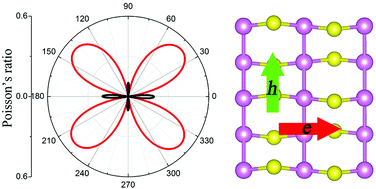Two-dimensional IV–VI materials with in-plane negative Poisson's ratio and anisotropic carrier mobility†
Abstract
Two-dimensional (2D) semiconductors with novel mechanical behaviors and electronic features are highly sought for a variety of potential applications. In this paper, by means of first-principles theory we study the mechanical and electronic properties of 2D IV–VI materials in detail, including SiS, SiSe, and Si2SSe. We reveal that the large values of negative Poisson's ratio (NPR) make these monolayers promising candidates for auxetic materials. Specifically, the in-plane NPR value of SiS monolayers reaches up to −0.19 in the x direction. In addition, the electrons in SiS monolayers have remarkably high mobility in the x direction, while the holes prefer to conduct in the y direction. Furthermore, under biaxial strain, the bandgaps of all these monolayers can be tuned effectively with ranges over 1.2 eV. All these appealing properties make SiS monolayers promising candidates for nanomechanic and optoelectronic applications.



 Please wait while we load your content...
Please wait while we load your content...